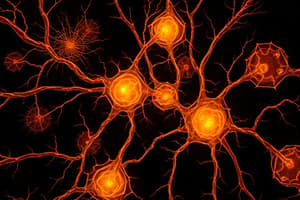Podcast
Questions and Answers
What type of cells transmit nerve impulses in the nervous tissue?
What type of cells transmit nerve impulses in the nervous tissue?
- Epithelial cells
- Nerve cells (correct)
- Neuroglia
- Glial cells
Which part of the neuron is primarily responsible for conducting impulses away from the cell body?
Which part of the neuron is primarily responsible for conducting impulses away from the cell body?
- Axon (correct)
- Synapse
- Dendrite
- Neuroglia
What are Nissl bodies primarily involved in within a neuron?
What are Nissl bodies primarily involved in within a neuron?
- Energy production
- Support for axons
- Protein synthesis (correct)
- Nerve impulse transmission
Which of the following correctly describes glial cells?
Which of the following correctly describes glial cells?
What is the function of dendrites in a neuron?
What is the function of dendrites in a neuron?
What causes the surface of dendrites to become rough?
What causes the surface of dendrites to become rough?
Which type of neuron is classified based on the number of their processes?
Which type of neuron is classified based on the number of their processes?
What defines Golgi type I cells?
What defines Golgi type I cells?
What is the main function of oligodendrocytes?
What is the main function of oligodendrocytes?
Which type of glial cell is involved in metabolic exchanges?
Which type of glial cell is involved in metabolic exchanges?
Flashcards are hidden until you start studying
Study Notes
Components of Nervous Tissue
- Composed of two cell types: nerve cells (neurons) and neuroglia (glial cells).
- Neurons are functional units that transmit nerve impulses; glial cells provide support, nourishment, and protection but are not excitatory.
Function of Nervous Tissue
- Receives stimuli from external and internal environments.
- Transmits stimuli to central parts: brain and spinal cord.
Location of the Nervous System
- Divided into Central Nervous System (CNS) and Peripheral Nervous System (PNS).
- CNS includes the brain and spinal cord; PNS consists of nerve fibers and ganglia.
- Contains over 100 million neurons, supported by numerous glial cells.
Neurons
- Responsible for the reception, transmission, and processing of stimuli.
- Comprises two main parts: cell body (perikaryon) and protoplasmic processes (axons and dendrites).
Cell Body (Perikaryon)
- Contains the nucleus, cytoplasm, neurofibrils, Nissl bodies, mitochondria, Golgi apparatus, centrioles, and pigments.
Protoplasmic Processes
- Axon: Efferent process, typically one per neuron, larger, less branched, lacks Nissl bodies but contains neurotubules and mitochondria. Functions in conducting nerve impulses and may receive information.
- Dendrites: Afferent processes, multiple per neuron, conduct impulses towards the cell body, contain Nissl bodies and mitochondria, characterized by a rough surface from gemmules.
Morphological Classification of Neurons
- Classified based on the number of processes: unipolar, bipolar, pseudo-unipolar, and multipolar cells.
- Functionally classified as sensory or motor neurons.
Classification Based on Axon Length
- Golgi type I cells: Long axons.
- Golgi type II cells: Short axons.
Glial Cells
- Supportive role in the nervous tissue despite neurons being the principal cell type.
- Classified based on origin and function.
Types of Glial Cells
- Oligodendrocytes: CNS origin, responsible for myelin production and electrical insulation.
- Schwann Cells: PNS origin, also involved in myelin production and electrical insulation.
- Astrocytes: CNS origin, provide structural support and facilitate metabolic exchanges.
- Ependymal Cells: CNS origin, line cavities of the central nervous system.
- Microglia: Originates from bone marrow, perform macrophagic activity within the CNS.
Studying That Suits You
Use AI to generate personalized quizzes and flashcards to suit your learning preferences.




